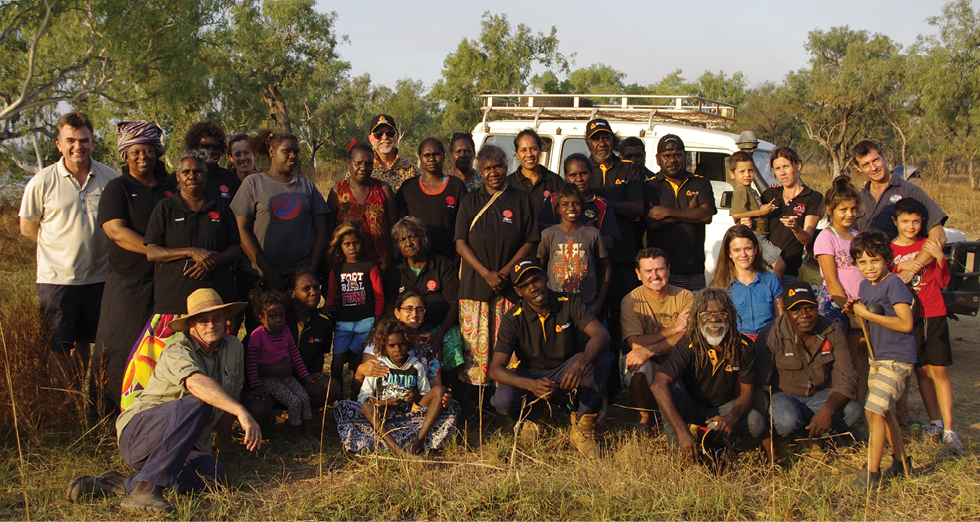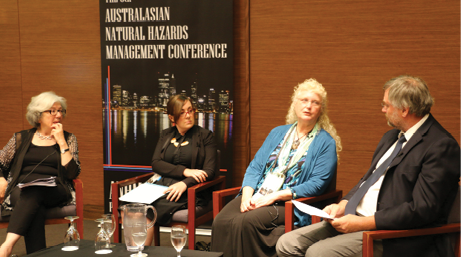Knowledge for life: how local knowledge is helping communities prepare
Freya Jones, Communications Assistant, Bushfire and Natural Hazards CRC
Article
There are many ways for a community to reduce its risk to the effects of hazards and disasters. Science and research play an important role, but for many remote and Indigenous communities, this cannot provide all of the solutions. Local knowledge can be pivotal to their risk reduction. To this end, the Bushfire and Natural Hazards CRC hosted a panel of speakers at the Australasian Natural Hazards Management conference in Perth as part of the 2015 International Day for Disaster Reduction.
This year’s conference theme, Knowledge for Life, focussed on traditional, local and Indigenous knowledge and practices to complement current science and research into resilience for communities and individuals. The idea for the International Day for Disaster Reduction was conceived in 1989 by the United Nations to promote a global culture and awareness of disaster reduction, prevention, mitigation and preparedness. Since 2009 it has been held on 13 October each year.

Research at Ngukurr in the Northern Territory shows harnessing knowledge, especially in remote Indigenous communities, is essential for disaster risk reduction. Image: Nathan Maddock, Bushfire and Natural Hazards CRC
The Bushfire and Natural Hazards CRC hosts the International Day for Disaster Reduction in Australia to ensure it remains on the national agenda. This year the day included a panel session at the 8th Australasian Natural Hazards Management conference that was held at the University of Western Australia, Perth from 13–14 October. The panel discussed assimilating local and traditional knowledge and practices as well as what partnerships are needed to help people in remote communities.
The panel comprised Professor Carmen Lawrence from the University of Western Australia, Erin Fuery, State Manager of Emergency Services in Western Australia and the Australian Red Cross, and Anne Garland, Research Associate of Applied Research in Environmental Sciences Non-profit in the United States.
Ms Fuery has worked with Indigenous and remote communities in Western Australia and presented some lessons learned by these communities following disaster. She explained that the Red Cross takes a ‘place-based’ approach when working with these communities.
Ms Fuery said, ‘This involves partnering Red Cross emergency services work with our community services people who are already on the ground delivering programs to communities in regional locations.’
Ms Fuery noted the importance of understanding local knowledge and how it can limit the impact of disasters and help to improve recovery. She believes it is crucial for emergency services organisations to work with the local community in the aftermath of a disaster.
‘In terms of finding solutions to some of these problems, it is about partnerships. It is about working with the community to find out what they need and being a facilitator to find the people who can find the solutions for them.
‘By partnering with community programs [we] help to ensure that emergency programs are relevant, culturally-appropriate and sustainable,’ Ms Fuery said.
Professor Lawrence has been conducting research on community perceptions of risk when experiencing hazards. She explained that perceptions of risk play a big role in how we prepare for disasters. Part of her research involved a large-scale national survey about how communities understand risks. This survey was conducted through the Bushfire CRC between 2010 and 2013.
Professor Lawrence said, ‘What we found were clear differences between communities and within those communities [there were] individuals who were better and less prepared. The communities who were best prepared and the individuals who were best prepared both had elevated perceptions of risk,’ she said.
The results of the survey demonstrated that those who had first-hand experience with bushfires or had participated in community groups dealing with bushfires were more likely to take action.
‘That participatory element was critical. Communities that did not have it did not prepare very well,’ she said.
Professor Lawrence also said there were clear differences in approaches to risk reduction and hazard preparation between those who live in the urban fringes of our cities and towns and people in rural areas.
‘People on the urban fringe have this view that someone else is going to do it, whereas people in the country tend to roll up their sleeves and do it together,’ she said.

The 2015 International Day for Disaster Reduction panel (left to right) Professor Carmen Lawrence, Erin Fuery, Anne Garland and Michael Rumsewicz. Image: David Bruce, Bushfire and Natural Hazards CRC.
Having worked with people in the remote community of Barrow, located right on the northern tip of Alaska, Anne Garland noted that these issues are not confined to Australia.
Ms Garland said, ‘In the Arctic, these people are facing hazards they have never had to face before.
‘The city of Barrow has lost about 100 feet of their coastline in the last 30 years,’ she said
The increasing threat of natural disasters places a heavy burden on these remote and often isolated communities, but Ms Garland believes they have a wealth of knowledge in dealing with disasters.
‘They have a huge background of resilience and risk understanding,’ she said of the Barrow community.
While the Australian environment is vastly different to Alaska, the issues faced are similar, and there is a lot we can learn from these types of communities, despite the geological differences.
The Bushfire and Natural Hazards CRC supports the International Day for Disaster Reduction to help researchers and those working in the field to continue to share their knowledge.
CRC Research Manager, Dr Michael Rumsewicz. said, ‘Our idea behind the International Day for Disaster Reduction is to get people who work in this area to discuss what is happening out in the field; what policy changes are being considered, and what new thinking is being brought to this area.
‘This is not a conversation that stops now. It has to continue. There is a lot of knowledge and research that needs to be passed around from different environments and we will hold this event annually in a different location around the country,’ he said.
With 39 events for the 2015 International Day for Disaster Reduction taking place in 31 countries, it is clear that risk reduction is a global concern affecting the international community. Rather than confining these concerns to one annual event, the Bushfire and Natural Hazards CRC, through its national research agenda exploring the causes, consequences and mitigation of natural disasters, will ensure that the crucial conversations around disaster reduction, prevention, mitigation and preparedness continue to take place in an everyday context.
| Watch highlights of the 2015 International Day for Disaster Reduction at www.bnhcrc.com.au. |


